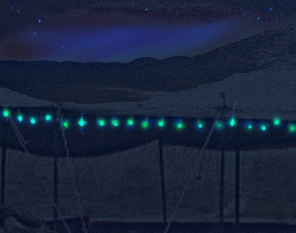What happened at Beit Bat Ya’anah: part 7
This is the seventh installment of a series. Click on the link at the bottom of the page to continue to the next installment. Or, click here to read from the very beginning. Previously:
After getting nowhere with the stamped symbol on the broken piece of pottery, Professor Einer Wayfarer disappointingly proclaimed to the dig staff, “ I’m afraid that until you find more evidence — like a related object — what you’ve got is a classic unsecured antiquity.” The entire trip had been a waste of time, and there was nothing to keep her longer at this remote desert excavation.
I’m afraid that until you find more evidence — like a related object — what you’ve got is a classic unsecured antiquity.” The entire trip had been a waste of time, and there was nothing to keep her longer at this remote desert excavation.
The Leopard and the Lioness
Wayfarer lay on top of her sheet on the camp cot, not sleeping. The mystery object which had drawn her to Beit Bat Ya’anah had been ambiguous at best, and disappointing, to say the least; not worth the fuss and travel. Personally, she was dismayed that Avsa’s enthusiasm for searching for physical evidence of an obscure culture had clearly gotten the better of her academic objectivity. Wayfarer knew her colleague was impetuous — it was a strength as well as a weakness — but it was imperative to remain detached from the subject, and Szeringka had either forgotten that, or, more disturbingly, abandoned an objective approach. This lapse had wasted a great deal of Wayfarer’s time. She was relieved to be leaving, and expected to be picked up next day by the department jeep to be delivered back to Beer-Sheva, then to the airport and back home in time to start preparing for the fall semester and to get some more editing done on the Lexicon before classes began. There was no reason she should be awake, thinking and sleepless.
Yet… Avsa Szeringka might have a quixotic academic cause, and she might be impulsive, but she was no fool. Why had she insisted that Wayfarer come to this remote, unpromising site? To see that unremarkable lump of clay with the uncertain symbol on it? It seemed unlikely. That question was keeping the professor awake; that question, and the heat.
It was stifling. No breeze stirred the oppressive night air — even with the end flaps open, the tent was a canvas oven. Feeling sleep evaporate once and for all, Wayfarer sat up to ponder means of relief for her sweltering insomnia and decided on a shower, despite Wilson Rankle’s regulations about hours and a limited water supply. Firmly squelching her conscience about that along with qualms about scorpions, centipedes and other nocturnal wildlife she risked encountering, Wayfarer shook out her sandals, slipped them onto her feet and grabbed a towel. The waxing half moon was still up, so she could see well without a flashlight. No need for proper clothes ; her nightgown would get her across camp — at three forty-five in the morning, everyone else was sleeping.
; her nightgown would get her across camp — at three forty-five in the morning, everyone else was sleeping.
But as she drew closer to the showers she could hear water running, the slap of droplets hitting the cement and spattering the tarp wall, their sound-pattern changing as someone moved around under the showerhead. Unbelievable, Wayfarer thought… it was 0-dark-30 and there was nocturnal wildlife around. She stopped, wondering if she should wait or go back to the tent, but like a lioness at the watering hole she decided to pull rank. “Hey,” she growled, “Are you almost done in there?”
No one replied, but the water shut off after a few seconds. Not knowing whether the bather was male or female, Wayfarer hesitated to push in; she stood outside the tarp overlap and waited. A scant moment later someone slipped out close by her, dripping wet, dark snakes of hair clinging to neck and shoulder blades, wearing a towel wrapped low around the hips and nothing else, except fisherman’s sandals.
fisherman’s sandals.
Through the camo shade mesh, the moonlight limned a sleek body, dappling a quantity of exposed, brown skin. Einer Wayfarer was stolidly immune to this sort of animal display – nearly naked young men were of no interest to her whatever – but her eyes followed the creature with academic curiosity, if nothing more ardent. It was no one she’d seen yet on site. She wondered if the local Bedouin boys ever snuck into camp for the luxury of water. But, no: as he passed her, Wayfarer’s nose detected a blend of cedar-scented soap and arak. A luxurious nocturnal creature, then, and dissolute, she decided uncritically. But clean.
As she stepped under the tepid flow herself, she belatedly realized the young man had said something as he’d passed: was it good morning? She tried to replay the words in her head; they hadn’t been English, or Hebrew. And not Arabic, either, yet she’d understood them perfectly well. Unable to reconstruct the phrase, Wayfarer shook her head, realizing she wasn’t as awake as she felt, and let the water run down her scalp and over her shoulders,  cooling her a little, but not much. It hardly mattered; by tomorrow night, she’d be on a plane home.
cooling her a little, but not much. It hardly mattered; by tomorrow night, she’d be on a plane home.
To be continued…
To read Part 8 “The Dawning”, click here




















